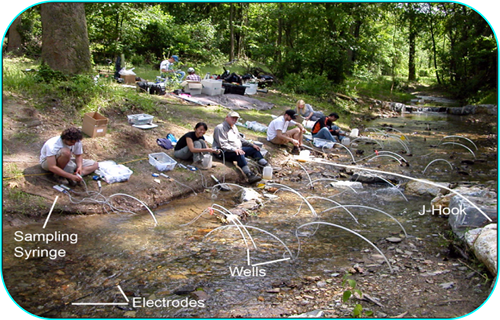 At Crabby Creek, PA we demonstrated the used of time-lapse resistivity tomography to monitor the progress of a saline tracer in the hyporheic zone (zone of groundwater/surface water interaction beneath a stream. This site was of particular interest because the reach we monitoring was constructed when the original stream began to undercut a municipal sewer line. This re-engineered section included a number of structures (J-hooks, cross-vanes) designed to create pools and riffles, provided a wonderful opportunity to study the development of a hyporheic zone in a newly-created stream.
At Crabby Creek, PA we demonstrated the used of time-lapse resistivity tomography to monitor the progress of a saline tracer in the hyporheic zone (zone of groundwater/surface water interaction beneath a stream. This site was of particular interest because the reach we monitoring was constructed when the original stream began to undercut a municipal sewer line. This re-engineered section included a number of structures (J-hooks, cross-vanes) designed to create pools and riffles, provided a wonderful opportunity to study the development of a hyporheic zone in a newly-created stream.
Publications and presentations on this site include:
Toran, L., B. Hughes, J. E. Nyquist, and R. J. Ryan (2013) Freeze core sampling to confirm time-lapse resistivity monitoring of the hyporheic zone, Ground Water, 51(4):635-640.
Toran, L., J. E. Nyquist, A. C. Fang, R. J. Ryan, and D. O. Rosenberry (2012) Observing heterogeneity in hyporheic flow with electrical resistivity and subsurface well sampling during a stream tracer test. Hydrologic Processes, doi: 10.1002/hyp.
Nyquist, J. E., L. Toran, B. Hughes, and R. Ryan (2011), Using hydrogeophysics to map temporal changes in the hyporheic zone, Proceedings of the SAGEEP ’11 Symposium for the Application of Geophysics to Environmental and Engineering Problems
Nyquist, J. E., L. Toran, A. C. Fang, R. J. Ryan, and D. O. Rosenberry (2010), Tracking tracer breakthrough in the hyporheic zone using time-lapse DC resistivity, Crabby Creek, Pennsylvania, Proceedings of the SAGEEP ’10, Symposium for the Application of Geophysics to Environmental and Engineering Problems, 7 pp.
